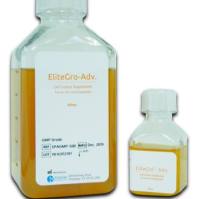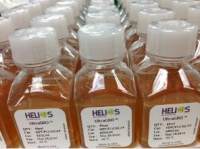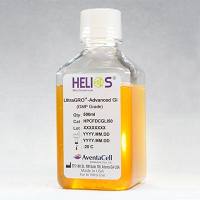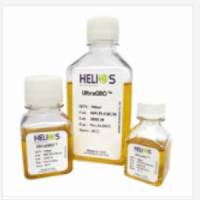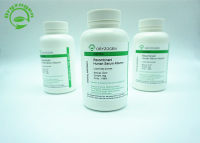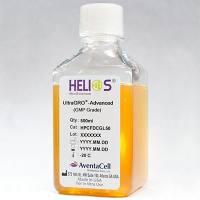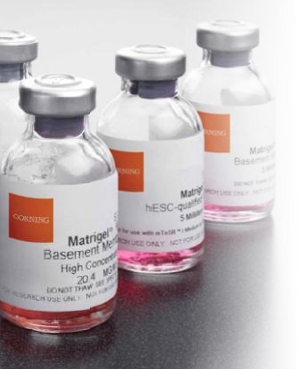
产品详情
文献和实验
相关推荐
保存条件 :-20
供应商 :美国康宁(原BD公司生产)
规格 :5ml
iPS\hES 细胞无饲养层培养专用基质胶:354277官方授权代理:广州合华科技有限公司,生物试剂耗材部 魏保森 18802052563
地址:广州天河区五山路371号中公教育大厦601
GUIDELINES FOR USE
PRODUCT: BD Matrigel™ hESC-qualified Matrix, 5 ml vial
CATALOG NUMBER: 354277
BACKGROUND:
Basement membranes are continuous sheets of specialized extracellular matrix that are found at the dermal-epidermal
junction, at the base of all lumen-lining epithelia throughout the digestive, respiratory, reproductive and urinary tracts
and that underlie parenchyma of endocrine and exocrine glands.
BD Matrigel™ Matrix is a soluble basement membrane extract of the Engelbreth-Holm-Swarm (EHS) tumor that gels
at room temperature to form a genuine reconstituted basement membrane. 1 The major components of Matrigel Matrix
are laminin, collagen IV, entactin and heparan sulfate proteoglycan. 2-3 Growth factors, collagenases, plasminogen
activators and other undefined components have also been reported in Matrigel Matrix. 4-5
STEM CELLS:
Historically, hES cell derivation and culturing techniques utilized serum and/or mouse embryonic fibroblast (MEF)
feeder layers. 6 An ideal environment for hES cell research consists of both a cell culture surface specifically
qualified for hES cells, and a serum-free, defined medium. BD Matrigel™ hESC-qualified Matrix and STEMCELL
Technologies’ mTeSR™1 (developed under license from the WiCell Research Institute 7 ), a high quality surface and
medium combination, create the first complete environment to support feeder-independent expansion of hES cells.
BD Matrigel hESC-qualified Matrix is an optimized surface for your stem cell research. It has been qualified as
mTeSR™1-compatible by STEMCELL Technologies, eliminating the need for time-consuming screening, while
providing the reproducibility and consistency essential for your hES cell research. When coupled with a variety of
culture media, Matrigel Matrix has been widely accepted as an alternative substrate for the culture of hES cells. 8-9
The mTeSR™1 formulation is defined and serum-free, and has been designed to maintain and expand hES cells in
an undifferentiated state when used with Matrigel Matrix as a substrate. It does not require any further addition of
growth factors or supplements.
The mTeSR™1 formulation and Matrigel Matrix have been shown to be a successful combination for culturing
different hES cell lines for up to 20 passages. 10 Cells maintained in mTeSR™1 express high levels of pluripotency
markers such as Oct-3/4 and SSEA-3, and pluripotency of cells maintained in mTeSR™1 has also been
demonstrated by the ability of these cells to differentiate into all three germ layers in the teratoma assay. 7,11
SOURCE: Engelbreth-Holm-Swarm (EHS) Mouse Tumor
FORMULATION: Dulbecco's Modified Eagle's Medium with 50 μg/ml gentamycin
Matrigel hESC-qualified Matrix is compatible with all culture media
STABILITY: Stable for a minimum of three months from day of shipment when stored at -20°C
Stable for a minimum of six months when stored in aliquots at -70°C
RECONSTITUTION AND USE:
Color variations may occur in frozen or thawed vials of BD Matrigel hESC-qualified Matrix, ranging from straw
yellow to dark red due to the interaction of carbon dioxide with the bicarbonate buffer and phenol red. This is normal,
does not affect product efficacy, and will disappear upon equilibration with 5% CO 2 .
Thaw Matrigel on ice. Once thawed, swirl the vial to ensure the Matrigel is evenly dispersed. Spray top of vial with
70% ethanol and air dry. Keep product on ice and handle using sterile technique. Dispense material into appropriate
aliquots, using pre-cooled tubes, and refreeze immediately. Avoid multiple freeze thaws. DO NOT STORE IN
FROST-FREE FREEZER.
CAUTION:
BD Matrigel hESC-qualified Matrix will gel rapidly at 22 o C to 35 o C. Thaw overnight at 4 o C on ice. Gelled Matrigel
may be re-liquified if placed at 4°C on ice for 24-48 hours.
SPC-354277 Rev 2.0 - 1 -
BD Biosciences - Discovery Labware For Research Use Only
DILUTION FACTOR:
The dilution is calculated for each lot based on the protein concentration. To use with STEMCELL Technologies’
mTeSR™1 medium, prepare aliquots according to the dilution factor provided on the Certificate of Analysis.
Aliquots may be stored at -70°C for up to six months. The volume of the aliquots is typically between 270-350 μL.
To Use: Add one aliquot of BD Matrigel hESC-qualified Matrix to 25 mL of DMEM/F-12 to coat four 6-well plates
(1 mL/well) or three 100 mm dishes (8 mL/dish).
REFERENCES:
1. Kleinman, H.K., et al., Basement membrane complexes with biological activity, Biochemistry, 25:312-18 (1986).
2. Kleinman, H.K., et al., Isolation and characterization of type IV procollagen, laminin, and heparan sulfate proteoglycan from
the EHS sarcoma, Biochemistry, 21:6188-93 (1982).
3. Bissel, D.M., et al., Support of cultured hepatocytes by a laminin-rich gel. Evidence for a functionally significant
subendothelial matrix in normal rat liver, Journal of Clinical Investigation, 79(3):801-12 (1987).
4. Vukicevic, S., et al., Identification of multiple active growth factors in basement membrane Matrigel suggests caution in
interpretation of cellular activity related to extracellular matrix components, Experimental Cell Research, 202:1-8 (1992).
5. McGuire, P.G., and Seeds, N.W., The interaction of plasminogen activator with a reconstituted basement membrane matrix
and extracellular macromolecules produced by cultured epithelial cells, Journal of Cellular Biochemistry, 40:215-27 (1989).
6. Thomson, J.A., et al., Embryonic stem cell lines derived from human blastocysts, Science, 282:1145-47 (1998).
7. Ludwig, T.E., et al., Feeder-independent culture of human embryonic stem cells, Nature Methods, 3(8):637-46 (2006).
8. Xu, C., et al., Feeder-free growth of undifferentiated human embryonic stem cells, Nature Biotechnology, 19:971-4 (2001).
9. Xu, C., et al., Immortalized fibroblast-like cells derived from human embryonic stem cells support undifferentiated cell
growth, Stem Cell, 22:972-80 (2004).
10. Ludwig, T.E., et al., Derivation of human embryonic stem cells in defined conditions, Nature Biotechnology, 24:185-7
(2006).
11. Amit, M., et al., Clonally derived human embryonic stem cell lines maintain pluripotency and proliferative potential for
prolonged periods of culture, Developmental Biology, 227:271-8 (2000)

广州合华科技有限公司
实名认证
金牌会员
入驻年限:11年

